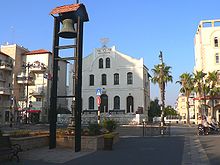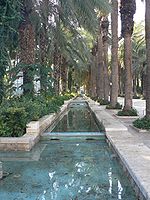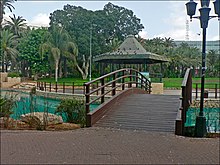Rishon LeZion
Template:Infobox Israel municipality

Rishon LeZion (Template:Lang-he-n , lit. First to Zion), is the fourth-largest city in Israel, located along the central Israeli coastal plain 12 kilometers south of Tel Aviv. It is part of the Gush Dan metropolitan area. The city had a population of 228,200 at the end of 2009.[1] Founded in 1882 by European Jewish immigrants, it was the second Jewish farm colony established in Land of Israel in the 19th century, after Petah Tikva.
Etymology

The name Rishon LeZion is derived from a biblical verse: "First to Zion are they, and I shall give herald to Jerusalem" (Hebrew: ראשון לציון הנה הינם, ולירושלים מבשר אתן) (Isaiah 41:27) and literally translates as "First to Zion".
History
Rishon LeZion was founded on July 31, 1882 by ten Hovevei Zion pioneers from Kharkov, Ukraine (then the Russian Empire) headed by Zalman David Levontin. Reuven Yudalevich was also a member of the group. The pioneers purchased 835 acres (337.91 ha) of land southeast of present-day Tel Aviv, part of the townland of the Arab village of Ayun Kara (literally ' fountain of the crier') .[1] [2] Ayun Kara was the scene of a bloody battle between Turkish and New Zealand troops on 14 November 1917.[3]. A stone cenotaph was erected by the people of Richon Le Zion to the memory of the New Zealanders who fell that day, but it has since been destroyed.[4][5]
The founders faced numerous difficulties. The soil was sandy, water was scarce and the settlers had no agricultural experience. After a well was dug and more pioneers arrived - the Biluim - the colony slowly took shape. Notable members of this group include Fani Belkind, Israel Belkind, Shimshon Belkind, Yoel Drubin, Dr. Haim Hissin, and David Yudilovich. When Baron Edmond James de Rothschild took over, sending in his administrators, major progress was made in the spheres of agriculture, citrus and viticulture. Under Rothschild's patronage, the Carmel-Mizrahi Winery was established in 1886.
David Ben-Gurion was head of workers' union at the winery before later becoming Israel's first prime minister. The first Hebrew school in the country opened in Rishon Lezion in 1889.[2] Dov Lubman Haviv taught there and Mordechai Lubman Haviv was an educational inspector. Eliezer Ben-Yehuda, known as the father of modern Hebrew, was a teacher in Rishon LeZion. In 1890, Rishon Lezion had a population of 359. Five years later, the figure had risen to 380, and by 1900, to 526. In 1911, 4,000 dunams of land in Rishon Lezion were planted with grapes and 254 dunams with other fruit orchards.[3]
Development was hindered by the lack of a water source. Baron Rothschild brought in experts who located water at 42 meters below ground. The groundwater table in the area was found to be uneven and wells were mostly constructed at between 20 and 25 meters in depth. Orchards were then developed around the settlement, and by the late 1920s the city developed a burgeoning citrus industry.[3]
Rishon was declared a city in 1950. By 1983 it had a population of 103,000. In 2006, 222,300 people were living in the city. By 2020, the population is expected to reach 315,000.[4] In 2007, the Rishon LeZion Municipality was awarded the Ministry of Interior Prize for Proper Management.[4]
Demographics
According to data from the Israel Central Bureau of Statistics as of December 2009, the number of residents in Rishon LeZion is 228,200. The annual growth of the population stands at 0.6%.[1] The predominant majority of the city's residents are Jews.
Economy
Rishon Lezion's main industries today are wine, construction, services and commerce. Factories and workshops are located in the old industrial zone, which has become a popular venue for pubs, dance clubs and restaurants. Industry in the city is largely divided into two industrial centers: the old industrial zone in the north of the city and the new industrial zone in the west of the city.[4] The two major malls in Rishon LeZion are Rothschild Center in the old downtown center and Gold Mall (Kenyon HaZahav) in the New West district. Companies such as Coca Cola, Gazit Globe, Volvo and Fiat are expected to open in the Maayan Sorek area.[4] As part of the city's 5-year plan to be completely water-independent,[5] construction of a desalination plant is planned for Rishon which will produce 3.7 million cubic meters of water per year, whilst the city already hosts the large Shafdan recycling plant.[4]
Local government

Mayors
- Eliakum Ostashinski (1950–1951)
- Aryeh Sheftel (1951)
- Moshe Gavin (1952–1955)
- Gershon Man Mankov (1955)
- Hana Levin (1955–1960)
- Aryeh Sheftel (1960–1962)
- Noam Laoner (1962–1965)
- Aryeh Sheftel (1965–1969)
- Hananya Gibstein (1969–1983)
- Meir Nitzan (1983–2008)
- Dov Tzur (2008–present)
Education and culture

Rishon LeZion has twenty-three elementary schools, nine middle schools and twelve high schools. Rishon Lezion's College of Management has a student population of 10,000.[4] Sixty percentage of twelve graders in the city qualify for a matriculation certificate.
Rishon LeZion holds an annual wine festival. The Rishon LeZion Amphitheatre has hosted overseas artists such as Sting, Metallica, Alanis Morissette and Sean Paul. The city has a municipal zoo, an amusement park (Superland), and a beach promenade. Heychal HaTarbut (Hall of Culture) is a venue for classical concerts, theatre performances and cultural events. It has a larger theatre for shows and two smaller ones for artistic workshops. The Israel Symphony Orchestra Rishon Lezion, has participated in music festivals all over the world. It was awarded the ACUM prize in 1991.
Landmarks
Landmarks in Rishon LeZion include the history museum; the Carmel Winery; the administrative center of Edmond James de Rothschild, now a soldiers' memorial; the Great Synagogue; the Well; the old water tower; and Beit Sefer Haviv, the first Hebrew School.
Geography
Rishon LeZion is located on the Israeli Mediterranean Coastal Plain and the northern Shephelah. The city experiences hot, dry summers, and cool, wet winters.
| Climate data for Rishon LeZion | |||||||||||||
|---|---|---|---|---|---|---|---|---|---|---|---|---|---|
| Month | Jan | Feb | Mar | Apr | May | Jun | Jul | Aug | Sep | Oct | Nov | Dec | Year |
| Mean daily maximum °C (°F) | 17.8 (64.0) |
18.8 (65.8) |
21.0 (69.8) |
24.6 (76.3) |
26.9 (80.4) |
29.2 (84.6) |
30.6 (87.1) |
31.1 (88.0) |
30.1 (86.2) |
27.9 (82.2) |
24.1 (75.4) |
19.5 (67.1) |
25.1 (77.2) |
| Mean daily minimum °C (°F) | 6.7 (44.1) |
6.9 (44.4) |
8.5 (47.3) |
11.0 (51.8) |
13.7 (56.7) |
17.1 (62.8) |
19.6 (67.3) |
20.0 (68.0) |
18.3 (64.9) |
15.0 (59.0) |
11.1 (52.0) |
8.2 (46.8) |
13.0 (55.4) |
| Average precipitation mm (inches) | 139.7 (5.5) |
88.9 (3.5) |
61 (2.4) |
20.3 (0.8) |
2.5 (0.1) |
0 (0) |
0 (0) |
0 (0) |
0 (0) |
27.9 (1.1) |
73.7 (2.9) |
144.8 (5.7) |
558.8 (22) |
| Source: YR.NO[6] | |||||||||||||
Neighborhoods

Rishon LeZion can be divided into four main quarters: the old city, the eastern housing projects, the northern (old) industrial zone, and Western Rishon LeZion. There is also an industrial zone on the southern tip of the city, next to Gan Sorek.
Old city
The old city of Rishon includes the original neighborhoods, some buildings dating back to Rishon's founding in 1881. This quarter is located in the city center, between and around Herzl and Jabotinsky Streets. It includes the following neighborhoods: Nahalat Yehuda (on the northernmost tip of Rishon); Neve Hillel; Bnot Hayil; Abramovich; Katzenelson; Remez (Giv'at Levinson), on the southwestern tip of old Rishon; Rishonim (Gan Nahum), to the east of Remez
Shikunei HaMizrah
The Eastern Housing Projects (Hebrew: שיכוני המזרח Shikunei HaMizrah) was Rishon's quick expansion to the east. It is dominated by the housing projects (shikunim) there, in the Shikunei HaMizrah neighborhood itself. The eastern projects stopped developing when they reached the fences of the Tzrifin military base. When Tzrifin will be sold to private contractors as planned, this quarter is expected to expand significantly with new lucrative housing projects. Other smaller neighborhoods include Revivim, Kidmat Rishon, Ne'urim, Rambam, Neve Hadarim, HaShomer, Kfar Arye, Mishor HaNof and Kiryat Simha.
Old industrial zone
The industrial zones in Rishon LeZion are called Mabat, an abbreviation for Miskhar, Bilui VeTa'asiya (Commerce, Pastime and Industry). The northern zone is the oldest and original industrial zone, once full of light industry and glass factories. Today, it is known for its prolific nightlife.
West Rishon

West Rishon LeZion is the conglomeration of the new neighborhoods of the city, built in the 1980s and 90s. The west also has higher land value because of its relative proximity to the Mediterranean Sea. It includes the entire city west of Tzahal Road. The quarter includes the new industrial zone (Western Mabat), and a number of residential neighborhoods: Neve Eliyahu (or Ramat Eliyahu), Ne'ot Shikma, Neve Dekalim, Neve Hof (or Pueblo Español), Neve Yam, Kiryat Rishon, Kiryat Cramim, Kiryat Ganim, Ne'ot Ashalim, Kiryat Hatanei Pras Nobel (lit Nobel Prize Laureates' Town)
Sports
Rishon LeZion is known for its achievements in handball and chess.[citation needed] In handball, Hapoel Rishon LeZion and Maccabi Rishon LeZion dominate the handball league. Hapoel has won more than seven domestic championships and cups in a row, with stars like goalkeeper Vladimir Zaikman and field-players Idan Maimon and Dudi Balsar. Its biggest rival, Maccabi took the championship title from Hapoel in 2005/06. Handball is also a dominant sport in Rishon LeZion high schools. The Amit Amal high school handball team has won the world championship several times.[citation needed] In chess, the Rishon LeZion Chess Club, founded in 1939, is one of the leading clubs in Israel, in senior, women and youth leagues. Israeli grandmasters such as Boris Alterman play for Rishon. World champion Garry Kasparov was a former member. Ironi Rishon LeZion was in the top division, but now plays in the second tier. The Maccabi Rishon LeZion basketball team is a long-time member of Ligat HaAl, the top division. The team was a rival to Israel's top club and European champion, Maccabi Tel Aviv in the 1990s.
Transportation
Rishon LeZion can be accessed by road from several major highways. Public transportation includes bus, train and share taxi.
Rail transport

The Rishon LeZion HaRishonim Railway Station is located to the south of the city center, in the middle of HaRishonim Interchange, at the intersection of the new Highway 431 and the Rishon LeZion – Ness Ziona road. There are direct trains from the HaRishonim Railway Station to Tel Aviv, Lod, Bnei Brak, Petah Tikva, Rosh HaAyin, Hod HaSharon and Kfar Sava. All stations of Israel Railways can be accessed using the transfer stations at Tel Aviv and Lod.
An additional station in the western part of the city, situated on the new rail line from Tel Aviv to Ashdod via Rishon LeZion and Yavne (West) is currently under construction and is expected to be completed in 2011. There are future long-range plans for some day connecting the Rishonim station with the new Western station, while constructing a couple of additional railway stations in between them.
Bus transport
The bus companies serving intercity lines in Rishon LeZion are: Egged, Dan, Connex, Metropoline, Superbus and Kavim. Rishon LeZion has an intracity bus network operated by Egged and Dan. Most lines are metropolitan, continuing to Bat Yam, Holon, Tel Aviv and Jaffa. The bus lines are augmented by share taxis operated by Moniyot HaIr.
Notable residents

- Yaacov Agam
- Zohar Argov, singer
- Tal Ben Haim, football/Soccer player
- Boris Gelfand, chess champion
- Felix Halfon, football player/Soccer
- Ya'akov Hodorov, goalkeeper
International relations
Twin towns — Sister cities
Rishon LeZion is twinned with:
During the Gulf War in 1991, the mayor of Münster, Germany, made a surprise visit to Rishon LeZion. According to Haaretz, he felt he could not sit quietly at home while missiles were falling on his sister city. Throughout the war, he stayed at the home of Rishon LeZion mayor Meir Nitzan and accompanied him on visits to sites hit by missiles.[8]
References
- ^ a b "Table 3 - Population of Localities Numbering Above 2,000 Residents and Other Rural Population" (PDF). Israel Central Bureau of Statistics. 2010-06-30. Retrieved 2010-10-30.
- ^ Early Hebrew schools in Eretz-Israel
- ^ a b Karlinsky, Nahum (2005). California Dreaming: Ideology, Society, and Technology in the Citrus. SUNY Press. p. 54. ISBN 0791465276. Retrieved 2008-04-05.
{{cite book}}: Unknown parameter|coauthors=ignored (|author=suggested) (help) - ^ a b c d e f "Municipality of Rishon LeZion Profile". Israel's Largest Enterprises 2008. Dun's 100. Retrieved 2008-04-05.
- ^ Green, Michael (16 October 2008). "Dig It!". The Jerusalem Post. Retrieved 2008-11-23.
- ^ "Weather statistics for Rishon LeZion in Central Israel (Israel)". yr.no. Retrieved 2010-09-01.
- ^ a b The Municipality of Lublin City
- ^ a b Choose your family, Haaretz

